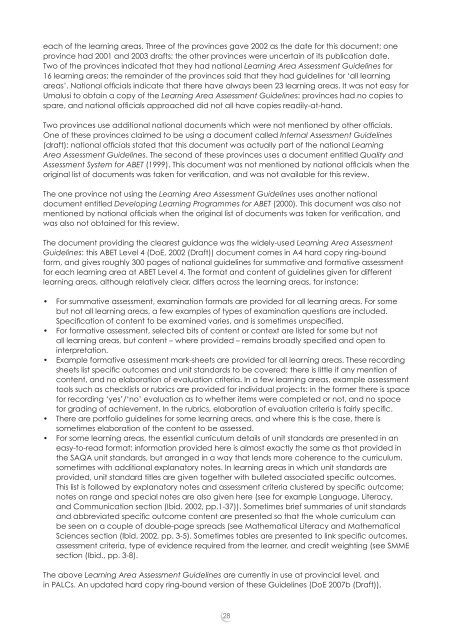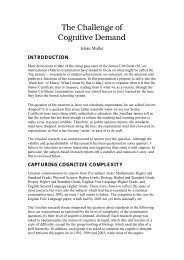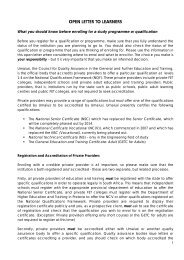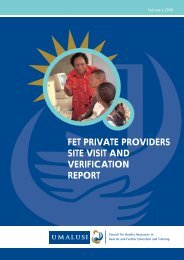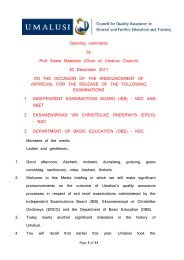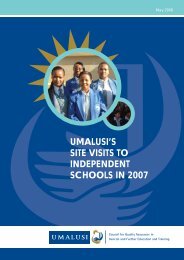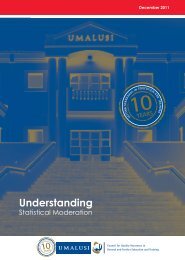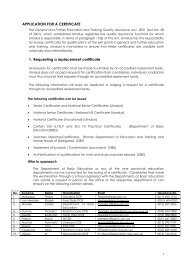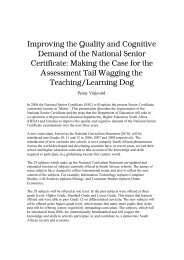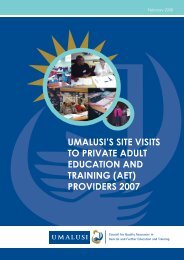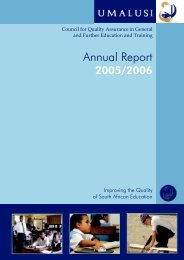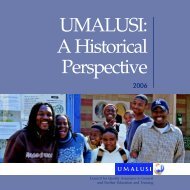Inspecting the Foundations - Umalusi
Inspecting the Foundations - Umalusi
Inspecting the Foundations - Umalusi
You also want an ePaper? Increase the reach of your titles
YUMPU automatically turns print PDFs into web optimized ePapers that Google loves.
each of <strong>the</strong> learning areas. Three of <strong>the</strong> provinces gave 2002 as <strong>the</strong> date for this document; oneprovince had 2001 and 2003 drafts; <strong>the</strong> o<strong>the</strong>r provinces were uncertain of its publication date.Two of <strong>the</strong> provinces indicated that <strong>the</strong>y had national Learning Area Assessment Guidelines for16 learning areas; <strong>the</strong> remainder of <strong>the</strong> provinces said that <strong>the</strong>y had guidelines for ‘all learningareas’. National offi cials indicate that <strong>the</strong>re have always been 23 learning areas. It was not easy for<strong>Umalusi</strong> to obtain a copy of <strong>the</strong> Learning Area Assessment Guidelines: provinces had no copies tospare, and national offi cials approached did not all have copies readily-at-hand.Two provinces use additional national documents which were not mentioned by o<strong>the</strong>r offi cials.One of <strong>the</strong>se provinces claimed to be using a document called Internal Assessment Guidelines(draft): national offi cials stated that this document was actually part of <strong>the</strong> national LearningArea Assessment Guidelines. The second of <strong>the</strong>se provinces uses a document entitled Quality andAssessment System for ABET (1999). This document was not mentioned by national offi cials when <strong>the</strong>original list of documents was taken for verifi cation, and was not available for this review.The one province not using <strong>the</strong> Learning Area Assessment Guidelines uses ano<strong>the</strong>r nationaldocument entitled Developing Learning Programmes for ABET (2000). This document was also notmentioned by national offi cials when <strong>the</strong> original list of documents was taken for verifi cation, andwas also not obtained for this review.The document providing <strong>the</strong> clearest guidance was <strong>the</strong> widely-used Learning Area AssessmentGuidelines: this ABET Level 4 (DoE, 2002 (Draft)) document comes in A4 hard copy ring-boundform, and gives roughly 300 pages of national guidelines for summative and formative assessmentfor each learning area at ABET Level 4. The format and content of guidelines given for differentlearning areas, although relatively clear, differs across <strong>the</strong> learning areas, for instance:• For summative assessment, examination formats are provided for all learning areas. For somebut not all learning areas, a few examples of types of examination questions are included.Specifi cation of content to be examined varies, and is sometimes unspecifi ed.• For formative assessment, selected bits of content or context are listed for some but notall learning areas, but content – where provided – remains broadly specifi ed and open tointerpretation.• Example formative assessment mark-sheets are provided for all learning areas. These recordingsheets list specifi c outcomes and unit standards to be covered; <strong>the</strong>re is little if any mention ofcontent, and no elaboration of evaluation criteria. In a few learning areas, example assessmenttools such as checklists or rubrics are provided for individual projects: in <strong>the</strong> former <strong>the</strong>re is spacefor recording ‘yes’/‘no’ evaluation as to whe<strong>the</strong>r items were completed or not, and no spacefor grading of achievement. In <strong>the</strong> rubrics, elaboration of evaluation criteria is fairly specifi c.• There are portfolio guidelines for some learning areas, and where this is <strong>the</strong> case, <strong>the</strong>re issometimes elaboration of <strong>the</strong> content to be assessed.• For some learning areas, <strong>the</strong> essential curriculum details of unit standards are presented in aneasy-to-read format: information provided here is almost exactly <strong>the</strong> same as that provided in<strong>the</strong> SAQA unit standards, but arranged in a way that lends more coherence to <strong>the</strong> curriculum,sometimes with additional explanatory notes. In learning areas in which unit standards areprovided, unit standard titles are given toge<strong>the</strong>r with bulleted associated specifi c outcomes.This list is followed by explanatory notes and assessment criteria clustered by specifi c outcome;notes on range and special notes are also given here (see for example Language, Literacy,and Communication section (Ibid. 2002, pp.1-37)). Sometimes brief summaries of unit standardsand abbreviated specifi c outcome content are presented so that <strong>the</strong> whole curriculum canbe seen on a couple of double-page spreads (see Ma<strong>the</strong>matical Literacy and Ma<strong>the</strong>maticalSciences section (Ibid. 2002, pp. 3-5). Sometimes tables are presented to link specifi c outcomes,assessment criteria, type of evidence required from <strong>the</strong> learner, and credit weighting (see SMMEsection (Ibid., pp. 3-8).The above Learning Area Assessment Guidelines are currently in use at provincial level, andin PALCs. An updated hard copy ring-bound version of <strong>the</strong>se Guidelines (DoE 2007b (Draft)),28


